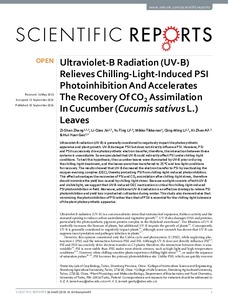Ultraviolet-B Radiation (UV-B) Relieves Chilling-Light-Induced PSI Photoinhibition And Accelerates The Recovery Of CO2 Assimilation In Cucumber (Cucumis sativus L.) Leaves
Qing-Ming Li; Yu-Ting Li; Zi-Shan Zhang; Xi-Zhen Ai; Mikko Tikkanen; Hui-Yuan Gao; Li-Qiao Jin
Ultraviolet-B Radiation (UV-B) Relieves Chilling-Light-Induced PSI Photoinhibition And Accelerates The Recovery Of CO2 Assimilation In Cucumber (Cucumis sativus L.) Leaves
Qing-Ming Li
Yu-Ting Li
Zi-Shan Zhang
Xi-Zhen Ai
Mikko Tikkanen
Hui-Yuan Gao
Li-Qiao Jin
NATURE PUBLISHING GROUP
Julkaisun pysyvä osoite on:
https://urn.fi/URN:NBN:fi-fe2021042715728
https://urn.fi/URN:NBN:fi-fe2021042715728
Tiivistelmä
Ultraviolet-B radiation (UV-B) is generally considered to negatively impact the photosynthetic apparatus and plant growth. UV-B damages PSII but does not directly influence PSI. However, PSI and PSII successively drive photosynthetic electron transfer, therefore, the interaction between these systems is unavoidable. So we speculated that UV-B could indirectly affect PSI under chilling-light conditions. To test this hypothesis, the cucumber leaves were illuminated by UV-B prior or during the chilling-light treatment, and the leaves were then transferred to 25 degrees C and low-light conditions for recovery. The results showed that UV-B decreased the electron transfer to PSI by inactivating the oxygen-evolving complex (OEC), thereby protecting PSI from chilling-light-induced photoinhibition. This effect advantages the recoveries of PSI and CO2 assimilation after chilling-light stress, therefore should minimize the yield loss caused by chilling-light stress. Because sunlight consists of both UV-B and visible light, we suggest that UV-B-induced OEC inactivation is critical for chilling-light-induced PSI photoinhibition in field. Moreover, additional UV-B irradiation is an effective strategy to relieve PSI photoinhibition and yield loss in protected cultivation during winter. This study also demonstrates that minimizing the photoinhibition of PSI rather than that of PSII is essential for the chilling-light tolerance of the plant photosynthetic apparatus.
Kokoelmat
- Rinnakkaistallenteet [19218]
